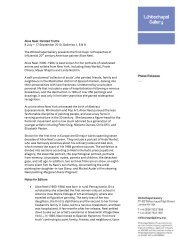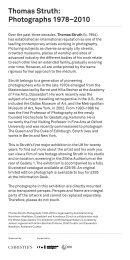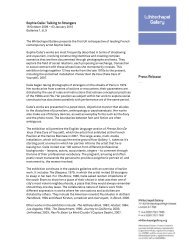For the happy man! - Collected writings DEPRESSION: Ed Atkins
For the happy man! - Collected writings DEPRESSION: Ed Atkins
For the happy man! - Collected writings DEPRESSION: Ed Atkins
Create successful ePaper yourself
Turn your PDF publications into a flip-book with our unique Google optimized e-Paper software.
spectacularly slim space between <strong>the</strong> cornea and <strong>the</strong> iris [my<br />
emphasis]. Situated behind <strong>the</strong> pupil is a colourless, transparent<br />
structure called <strong>the</strong> CRYSTALLINE LENS (think: <strong>the</strong><br />
plastic beak of a cuttlefish). Ciliary muscles have <strong>the</strong> lens<br />
surrounded. These thuggish muscles hold <strong>the</strong> lens in place<br />
but <strong>the</strong>y also play an important, <strong>man</strong>ipulative role in vision<br />
per se. When <strong>the</strong> muscles relax, <strong>the</strong>y yank on and iron down<br />
<strong>the</strong> lens, allowing <strong>the</strong> eye to see objects (bucolic landscapes)<br />
that are far away. To see closer objects clearly (<strong>the</strong> too-close<br />
face, looming in for a drunken, booze-saturated snog), <strong>the</strong><br />
ciliary muscle must contract, shrivel up in order to thicken<br />
<strong>the</strong> lens. The interior chamber of <strong>the</strong> eyeball is filled with a<br />
jelly-like tissue called <strong>the</strong><br />
VITREOUS HUMOUR.<br />
This place is like a flotation tank –<br />
meditative, though<br />
certainly not for<br />
you and your<br />
hysterical claustrophobia.<br />
A wet lift.<br />
The surprisingly<br />
cramped belly of<br />
<strong>the</strong> whale. Anyway,<br />
after passing<br />
through <strong>the</strong> lens,<br />
light must travel<br />
through this vault<br />
and its stagnant pool<br />
of stinking vitreous<br />
humour before strik-<br />
ing <strong>the</strong> sensitive layer<br />
of cells called <strong>the</strong> retina. The retina is <strong>the</strong> innermost of three<br />
tissue layers that make up <strong>the</strong> eye. These are unimaginably<br />
thin. The outermost layer, called <strong>the</strong> SCLERA, is what gives<br />
most of <strong>the</strong> eyeball its white colour; <strong>the</strong> rest of it is provided<br />
by a complex system of mirrors erected to reflect <strong>the</strong> image of<br />
a scrubbed femur. The cornea is also a part of <strong>the</strong> outer layer.<br />
The middle layer between <strong>the</strong> retina and sclera is called <strong>the</strong><br />
CHOROID. The choroid contains billions of blood vessels<br />
that supply <strong>the</strong> retina with nutrients and oxygen and also removes<br />
its waste products in an undocumented process we all<br />
find incomprehensible. Embedded in <strong>the</strong> retina are millions<br />
and millions of light sensitive cells, which come in two main
















